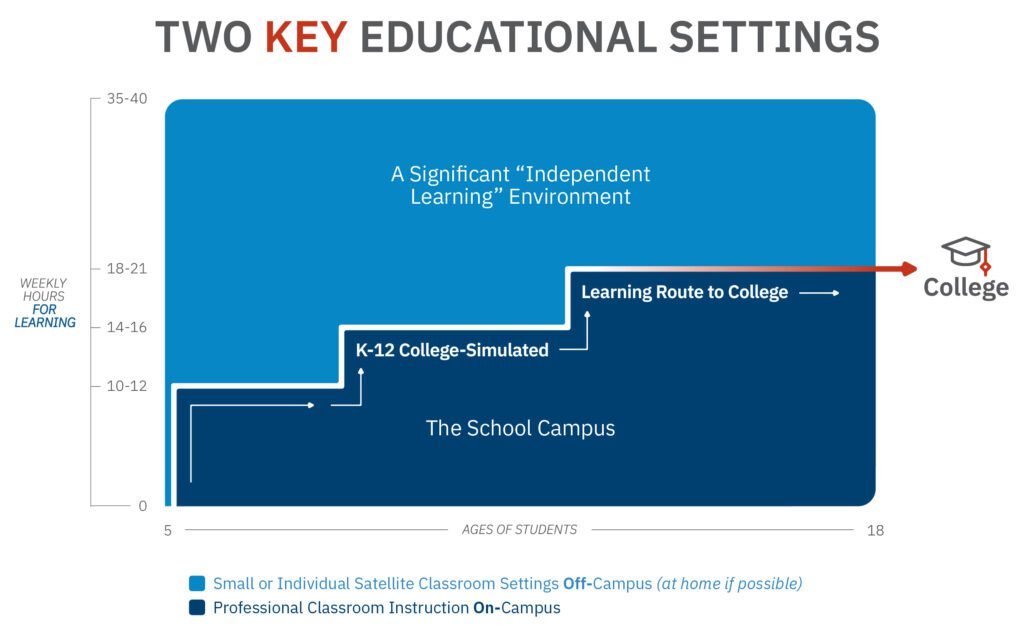
The School Campus!
Most parents recognize the importance of a school campus and the professionally trained educators who are there in person to teach, motivate, and inspire students toward higher levels of learning. They also recognize that a traditional school campus offers accountability for learning, classroom dynamics that help encourage student achievement, and the many resources, services, and activities normally associated with a school campus. College-Simulated Learning for K-12 utilizes the best of what a traditional school has to offer but in a manner that eliminates waste, reduces student burnout, and increases a student’s desire to attend school.


A Significant Independent Learning Environment Off Campus!
While the importance of a school campus is readily acknowledged, the importance of a significant Independent Learning Environment off campus is often overlooked. We use the word “significant” because it takes a tremendous amount of time for students to develop their independent learning skills. And “off campus” is an equally important feature! Although it does not have to be a student’s home, the home environment usually offers K-12 students the best off-campus setting to gradually develop their independent learning skills and the many character traits needed to improve and master those skills.
Similar to a college, a K-12 school utilizing College-Simulated Learning is structured to allow for a high level of independent work at home (Asynchronous Learning). As a result, students in grades K-12 receive the gradual opportunities needed to develop their time-management skills, organization skills, study and research skills, and the self-discipline and work ethic they will eventually need for success in college, technical school, and the workforce. Increasing a student’s learning time at home is also cost-effective and naturally provides more opportunities for parent involvement – one of the most determining factors in the success of a child’s education and the success of a child’s character and moral development.

A College-Simulated Weekly Schedule & Yearly Attendance Calendar!
Colleges and universities across the country have a long history of recognizing the importance of focused in-person instruction on campus and the importance of independent learning off campus (study outside of class). They also have a long history of efficiently and effectively coordinating these two essential learning environments through their weekly class schedule and their yearly attendance calendar. With the benefit of an involved parent (or a parent-of-record representative), a college’s weekly schedule and yearly calendar can also be readily utilized for grades K-12.

Although weekly schedules will vary from school to school with College-Simulated Learning, the younger grades typically attend classes on campus only 2 days per week (10-12 hrs.) with 3 days of learning off campus. The middle grades usually attend classes on campus 3 days per week (14-16 hrs.) with 2 days of learning off campus. High school students (at least by grade 11) normally attend classes using a weekly schedule (18-21 hrs.) that fully simulates that of a college, with some classes on M-W-F and other classes on Tu-Th, and with their independent learning time dispersed throughout the week. As in college, ALL classes are directed by professional instructors.
The result is a gradual transition of students directly into a college setting where they are (1) well prepared for the level of focused instruction that will take place in the classroom as well as (2) the level of independent work that will be expected outside of that classroom (Asynchronous Learning).


The Right Balance is Far More Effective!
Also significant is the yearly attendance calendar. While more time in school seems to be the preferred direction by many in K-12 education, it can actually be counterproductive to achieving a better education. The right balance is far more effective! And since encouraging long-term learning should be a goal of every school across the country, minimizing burn-out and increasing a student’s love of learning should be paramount.
The yearly attendance calendar utilized at most colleges (with intense 16-week Fall & Spring semesters) serves this purpose well and is typically adopted by K-12 schools using the College-Simulated Approach. Such a calendar also leaves room for a summer semester to spread out the number of intense courses for high school students or to provide remedial work for younger students.


